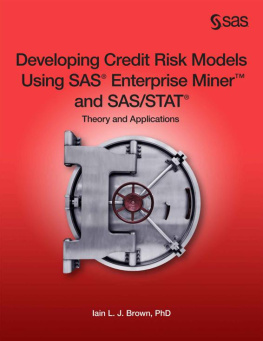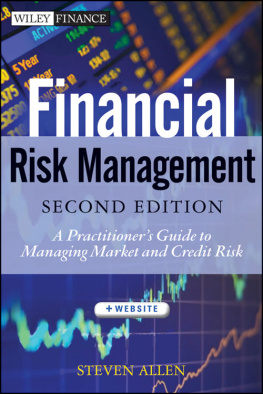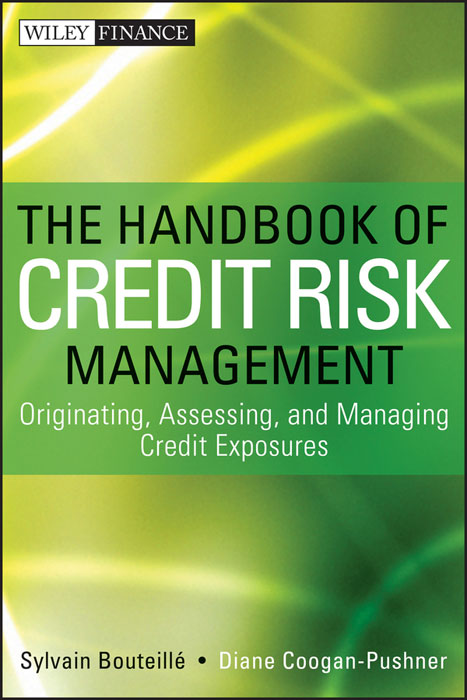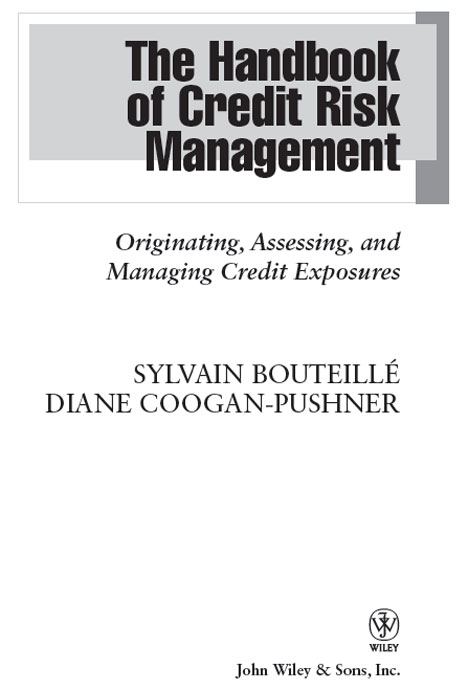Founded in 1807, John Wiley & Sons is the oldest independent publishing company in the United States. With offices in North America, Europe, Australia, and Asia, Wiley is globally committed to developing and marketing print and electronic products and services for our customers' professional and personal knowledge and understanding.
The Wiley Finance series contains books written specifically for finance and investment professionals as well as sophisticated individual investors and their financial advisors. Book topics range from portfolio management to e-commerce, risk management, financial engineering, valuation and financial instrument analysis, as well as much more.
For a list of available titles, visit our website at www.WileyFinance.com .
Cover design: Leiva-Sposato
Cover image: Jason Reed/Getty Images
Copyright 2013 by Sylvain Bouteill and Diane Coogan-Pushner. All rights reserved.
Published by John Wiley & Sons, Inc., Hoboken, New Jersey.
Published simultaneously in Canada.
No part of this publication may be reproduced, stored in a retrieval system, or transmitted in any form or by any means, electronic, mechanical, photocopying, recording, scanning, or otherwise, except as permitted under Section 107 or 108 of the 1976 United States Copyright Act, without either the prior written permission of the Publisher, or authorization through payment of the appropriate per-copy fee to the Copyright Clearance Center, Inc., 222 Rosewood Drive, Danvers, MA 01923, (978) 750-8400, fax (978) 646-8600, or on the Web at www.copyright.com . Requests to the Publisher for permission should be addressed to the Permissions Department, John Wiley & Sons, Inc., 111 River Street, Hoboken, NJ 07030, (201) 748-6011, fax (201) 748-6008, or online at http://www.wiley.com/go/permissions .
Limit of Liability/Disclaimer of Warranty: While the publisher and author have used their best efforts in preparing this book, they make no representations or warranties with respect to the accuracy or completeness of the contents of this book and specifically disclaim any implied warranties of merchantability or fitness for a particular purpose. No warranty may be created or extended by sales representatives or written sales materials. The advice and strategies contained herein may not be suitable for your situation. You should consult with a professional where appropriate. Neither the publisher nor author shall be liable for any loss of profit or any other commercial damages, including but not limited to special, incidental, consequential, or other damages.
For general information on our other products and services or for technical support, please contact our Customer Care Department within the United States at (800) 762-2974, outside the United States at (317) 572-3993 or fax (317) 572-4002.
Wiley publishes in a variety of print and electronic formats and by print-on-demand. Some material included with standard print versions of this book may not be included in e-books or in print-on-demand. If this book refers to media such as a CD or DVD that is not included in the version you purchased, you may download this material at http://booksupport.wiley.com . For more information about Wiley products, visit www.wiley.com .
Library of Congress Cataloging-in-Publication Data:
Bouteill, Sylvain.
The handbook of credit risk management : originating, assessing, and managing credit exposures / Sylvain Bouteill, Diane Coogan-Pushner.
p. cm. (Wiley finance series)
Includes index.
ISBN 978-1-118-30020-6 (cloth); ISBN 978-1-118-42146-8 (ebk);
ISBN 978-1-118-43389-8 (ebk); ISBN 978-1-118-30020-6 (ebk)
1. CreditManagement. 2. Risk management. I. Coogan-Pushner, Diane. II. Title.
HG3751.B68 2013
332.7dc23
2012032288
To my wife, Setsuko; my sons, Pierre and Franois; and my parents
Sylvain Bouteill
To my Dad
Diane Coogan-Pushner
Preface
The financial crisis, which struck the global economy in the late 2000s and continues today with the European sovereign debt troubles and ongoing banking fallout, reminds us of the relevance of sound credit risk management principles and processes. It serves as a powerful wake-up call for executives of industrial companies and financial institutions across the globe. Even simple financial transactions performed daily can create heavy losses and jeopardize the very existence of a firm. Are the customers able to pay? What happens if the bank where money is deposited defaults? Can broker dealers that hold collateral disappear overnight?
For everybody, the crisis (which we refer to as the 2007 crisis because in 2007, delinquencies on mortgages began occurring on a large scale and Standard & Poor's [S&P] downgraded thousands of asset-backed securities) and the collapse of major financial institutions offers an opportunity to take one step back and to rethink the basics of credit risk management. It is too often viewed only as the art of assessing single name counterparties and individual transactions. Credit risk management is more than that. The management of a credit risk portfolio involves four sequential steps:
Origination
Credit assessment
Portfolio management
Mitigation and transfer
Each one must be individually well understood, but, also, the way they interact together must be perfectly mastered. It is only by fully comprehending the entire chain that risk professionals can properly fulfill their task of protecting the balance sheet of the firms employing them.
We provide a comprehensive framework to manage credit risk, introducing one of the four essential steps in each part of the book. This book is based on our professional experience and also on our experience of teaching credit risk management to graduate students and finance professionals. Next, we provide an overview of each part.
PART ONE: ORIGINATION
Part One focuses on the description of credit risk and on the credit risk taking process in any organization involved in credit products. We also provide a simple checklist to analyze new transactions.
In Chapter 1 (Fundamentals of Credit Risk), we define credit risk and present the major families of transactions that generate credit risk for industrial companies and financial institutions. We conclude with the main reasons why properly managing a portfolio of credit exposures is essential to generate profits, produce an adequate return on equity or simply survive.
In Chapter 2 (Governance), we present the strict rules that must be in place within all institutions taking credit risk. It all starts with clear and understandable credit policies or guidelines. Then, in order to control accumulation, we discuss the role of limits on similar exposures. We also provide a concrete framework to approve new transactions. To finish, we discuss the human factor: how a risk management unit must be staffed and where it must be located inside an organization.
In Chapter 3 (Checklist for Origination), we introduce nine key questions that must be answered before accepting any transaction generating credit risk. It may sound trivial, but the best way to avoid credit losses is not to originate bad transactions. All professionals involved in risk taking must, therefore, ask themselves essential questions such as these: Does the transaction fit the strategy? Does it fit into the existing portfolio? Is the nature of the credit risk well understood? Is the deal priced adequately or is there an exit strategy?









